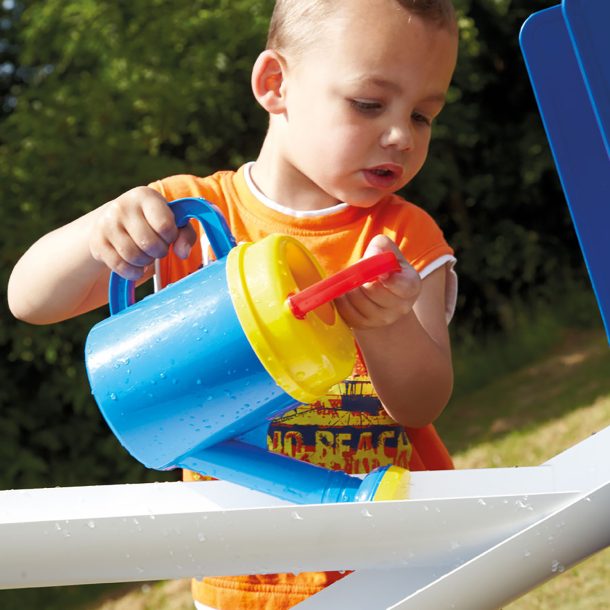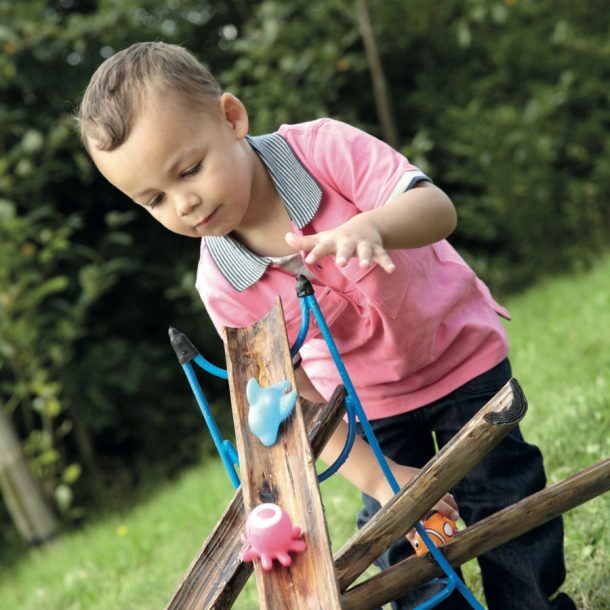Water play is one of the keen favourites within my setting so I find guttering to be one of my go to items. Previously, I would collect shorter off cuts or purchase larger pieces from a DIY store. But, the TTS jumbo guttering is a superb example of why you should save to purchase a high quality outdoor item like this from an educational site. It is extremely strong, sturdy and safe. With the rigorous testing undertaken by TTS, the jumbo guttering is ideal for outdoor play in busy settings. The possibilities are endless! The children love to explore and experiment and it naturally lends itself to water play, but also works brilliantly for other activities involving the movement and transportation of objects.
There are many different ways guttering can be used to support outdoor play.
Here are just a few:
Water play
- Use a variety of containers such as watering cans, giant teapots, funnels, scoops and buckets. Try to include some with handles and others without to develop fine and gross motor skills. Can the children transport the water and pour it down the guttering? Which recepticles work best? Which create a greater flow of water? Challenge the children to make the water run faster or slower by experimenting with the angles and positioning of the guttering.
Block or roll?
- Find items made from different materials to pour or place into the guttering. These could be natural items such as twigs, pinecones, pebbles or conkers, or other objects such as different types of balls. Which items roll down the guttering? Do any block the way? Can the children find ways to make the objects that block the path move (e.g. twigs) or those that already move, move faster? Which materials will aid the movement? Provide opportunities to experiment by adding things such as mud, sand (dry and wet) or water.
A day at the races
- Why not get competitive and have races. The first person to get their object into the bucket placed at the bottom of the guttering wins the race. Children can experiment by rolling down different objects. They may wish to race using balls, water, or sea creatures. Alternatively, add numbered fish or ducks and predict who will come first, second and third.
Small world play
- Use the guttering to create small worlds. The guttering may take on an icy feel when covered in tin foil or become an empty river bed with sand, small stones and pebbles scattered along the bottom. Add small world resources such as figures, vehicles, boats or animals so that the children can experiment with language and weave stories into their play.
Pattern making
- Line the guttering with paper. Dip objects such as textured balls, stones, apples or small pumpkins into different coloured paint and roll down the guttering. What textures and patterns can they make?
Design a waterfall or water channel
- Watch as children cooperate and collaborate to design and build a water channel or waterfall using guttering, stands, crates or other items. How can they work together to move and position the different pieces of guttering? Encourage children to test their creations to see if the water flows from one piece of guttering to the next or overflows and spills on to the ground. Challenge the children to work together to see if they can solve the problem. They may also wish to experiment with creating channels or waterfalls of different lengths or heights.
Building dams
- After the children have created water channels, ask them if they can think of ways to block the flow of water. If the children are interested, this may lead to discussions around dams and why they are used in real life. Can they break the dam using different strategies? In doing so, the children will experiment with force (pushing the blockage away), gravity as they change the angles of the guttering, and viscosity (by adding water to dry mud or sand). You could hide items in the dam to find. See the delight on the children’s faces as they unblock the dams, revealing the hidden objects within.
Overall, guttering is a great resource for encouraging natural cooperation. It promotes the development of social, cognitive, and communication skills, along with creative thinking. Children can work together to manipulate and manoeuvre the guttering and materials used alongside. This encourages open-ended play in which the children are in full control. Personally, I see guttering as a big loose part. I don’t think it should be permanently attached by a practitioner to fencing or stuck on the same guttering ramp in the same position at all times. It would be a shame to loose the opportunity of sparking creativity and problem solving skills by not having guttering out readily accessible for children to pick up, position and assemble how they wish, on whatever they wish.
Thank you to Kelly at Tinker Tent for sharing her thoughts and ideas with us in this blog.









